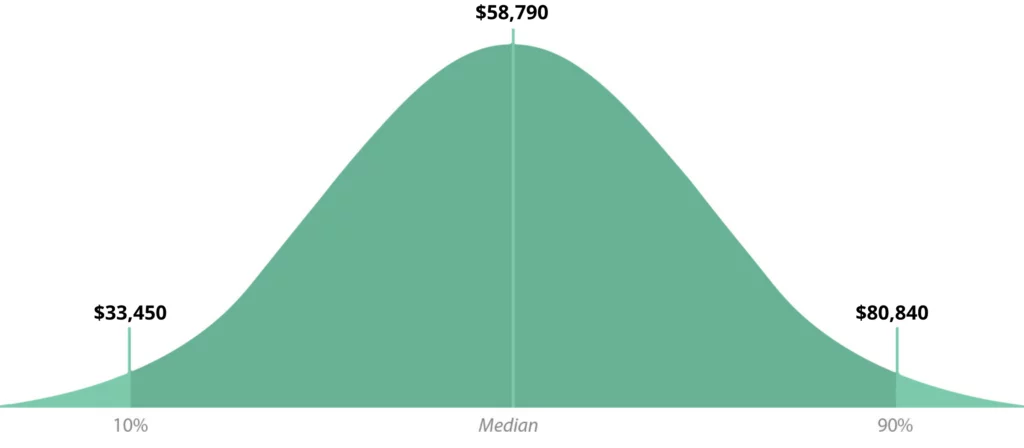
1. Overview: Job Responsibilities, Salary, and Common Requirements
2. A Comprehensive Guide to Becoming a Physical Therapist Assistant
3. What Does a Physical Therapist Assistant Do?
4. Signs You Should Consider Becoming a Physical Therapist Assistant
5. How Do You Become a Physical Therapist Assistant?
6. What are the Knowledge and Skills Needed to be a Physical Therapist Assistant?
7. Popular Schools and Colleges in the U.S. for Aspiring Physical Therapist Assistants
8. How to Get a Job as a Physical Therapist Assistant
9. Learn About Geographic and Location Pay Differentials
10. Make Your Resume Stand Out
11. Ace Your Physical Therapist Assistant Interview
12. Top Online Courses for Aspiring Physical Therapist Assistants
Physical Therapist Assistant made a median salary of $58,790 in 2019. The best-paid 10 percent earned $80,840 that year, while the lowest-paid 10 percent earned $33,450.

Dental Assistants
Medical Assistants
Pharmacy Technicians
Nursing Assistants and Orderlies
Psychiatric Technicians and Aides
Respiratory Therapists
Rehabilitation Counselors
Communication skills
Observation skills
Knowledge in therapeutic exercises
Clinical problem solving skills
Computer skills
Physically fit
Organization skills
The demand of Physical Therapist Assistants (PTAs) in the current workforce is quite high despite the slowdown of economic activity. According to the Bureau of Labor Statistics, the projected growth of employment for PTAs from 2019-2029 is 33%. This is because of the increasing number of the aging population’s healthcare needs, such as those who had strokes, heart attacks, mobility-related injuries, and other chronic conditions.
Here is your step-by-step guide and general ideas of everything you need to know on how to become successful in the PTA field.
Physical Therapist Assistants perform tasks that are usually indirectly related to patient treatment. Their primary responsibility is to aid and work under the supervision of a licensed Physical Therapist (PT), who is the only one responsible for providing physical therapy services to patients.
Duties of a person in a PTA position include but are not limited to:
A PTA’s job may seem to be a routine for some, especially to those with untrained eyes. However, the list above demonstrates that there are so many tasks of PTAs that they need to do in their shift. Discover if you are a great fit as PTA on to our next topic.
Are you one of those people who are genuinely comfortable in listening and giving advice about other people’s concerns? Do you want to make a meaningful difference in the lives of many patients?
The PTA’s job responsibilities are more than just restoring the mobility of their patients. One of the primary roles of a PTA is to provide quality care for their patients. Thus, to become a successful PTA, you must possess most of these traits.
Research uncovered that there is a link between chronic pain and depression or anxiety disorder. When a patient is going through chronic physical pain that affects their mobility, they tend to isolate themselves, which can lead to depression because of their negative thoughts. That is why PTAs should have a positive attitude that they can share with their patients. If a PTA shows optimism and believes that their treatment program will help their patients, then their patients will also gain that kind of positivity.
All patients have different responses to treatments. Some recoveries might take longer, therefore, making some patients feel discouraged and feel like giving up as they have to endure the long process of treatments. Because of this, some patients refrain from doing the therapy and become ill-tempered. When faced with this situation, PTA will have to use patience in encouraging their patients to perform the necessary treatments and to be in control of the situation.
A PTA should make their patients feel that they understand what they are going through and they know how their patients feel. This way, PTAs can build a connection with their patients on a personal level. Compassion is the result of empathy for another person. When we understand what the other person is experiencing (empathy), it motivates us to reach out and help (compassion).
According to research, expressing compassion and empathy has a significant effect in improving recovery rates and the satisfaction of patients. That is why a PTA needs to possess these two qualities.
This characteristic does not oppose the trait as mentioned earlier of a PTA, being compassionate and empathetic. PTAs are dealing with different kinds of patients with different personalities; thus, they need to be emotionally flexible. The old saying applies: resilient people are like bamboo in a hurricane—they bend rather than break. Although PTAs understand what a patient is going through emotionally, they know their boundaries. That is why they do not allow their patient’s stress spill over their personal life.
The job responsibility of a PTA requires them to be physically fit. They help patients regain mobility due to injuries or diseases, and they sometimes need to assist their patients, carry them, and demonstrate the exercises of movement techniques. Most importantly, they serve as a role model for the patients to have a healthy and active lifestyle.
Promoting health and wellness through prevention, treatment, and health care management are just some of the main contributions of PTAs to society. One of the leading causes of morbidity and mortality not only in the U.S. but in most countries is lifestyle or chronic diseases, also called noncommunicable diseases (NCDs). The main reasons for these are lack of physical activities and unhealthy diet and lifestyle.
PTA can reduce these factors by promoting or educating people with the right health and wellness, making a lasting contribution to society.

Now that you have an idea of what PTAs are, their job responsibilities, traits or characteristics, salary, and job outlook, here is the step-by-step guide to becoming a PTA.
The Commission on Accreditation in Physical Therapy Education (CAPTE) has about 371 numbers of accredited associate degree programs that usually lasts for two (2) years with (5 semesters). The CAPTE is the only recognized accrediting agency for PTA education.
Enrolling to any of these CAPTE programs will help prepare the students to pass the national licensure examination for them to work as a licensed PTA in all 50 states.
The curriculum includes the following subjects, but not limited to:
To see the full list of schools that offer accredited PTA programs in the U.S., go to this section of the career guide: Popular Schools and Colleges in the U.S. for Aspiring Physical Therapist Assistants.
All 50 states in the U.S. require PTAs to have a license or certification (and renewed on a regular basis). PTAs can obtain this by passing the National Physical Therapy Examination (NPTE); it is a computer-administered examination administered by the Federation of State Boards of Physical Therapy (FSBPT).
All PTA graduates are required to take and pass the exam to become a licensed or certified PTA. The examination is composed of 200 multiple choice questions that are divided into four (4) sections. Every state has different requirements for jurisdictions. That is why it is important that you contact your licensing authority to find out what your jurisdiction requires.
Now that you have earned an associate degree and passed the NPTE examination, you can start honing your skills by gaining clinical experience. The projected growth of the employment for PTAs from 2019-2029 is 33%, as per the Bureau of Labor Statistics report.
Most PTAs work in hospitals and privately owned PT clinics. Other PTA work settings include:
PTAs usually treat patients who have (but not limited to) the following conditions:
PTAs can transition on their career and continue their education to become a Physical Therapist (PT). A “bridge” program is designed to bridge the gap between the skills and knowledge of a PTA with the required skill set to become a PT or Doctor of Physical Therapy (DPT). Because of the bridge program, some of the undergraduate PTA courses can turn to account toward the PT degree and should complete additional PT courses prerequisites.
There are also different kinds of educational delivery formats aside from bridge programs that a student can choose from, such as hybrid distance, accelerated, online coursework, and weekend. Students who are entering these programs should possess an associate degree from an accredited PTA program and a baccalaureate degree from a 4-year institution.
Most employers require their PTAs to have a Basic Life Support (BLS) certification from the American Heart Association (AHA). It is an emergency medical care given to a person who needed to maintain their vital signs until they get to a hospital.
Students who successfully completed the curse will receive a course completion card that is valid for two (2) years. The course covers:
Contact the nearest BLS training center near your area or your employer for more information in selecting the correct BLS course.
The following skills are the necessary requirements for Physical Therapist Assistants to become successful in this field.
Communication is one of the top skills PTAs need to do in order to perform their job successfully. One must know how to communicate with their patients and the patients’ family members effectively. This sometimes includes being sensitive and observant of the patients’ mood, body language, and nonverbal cues.
PTAs should listen to their patients’ concerns and stories without interruptions or rushing them. Part of having a good communication skill is actively listening to the patients while showing confidence, empathy, compassion, and giving them encouragement.
Patients would love to hear a clear explanation of their diagnosis. PTAs are responsible for communicating this with their patients; thus, instead of using medical terms, analogies and metaphors are used for them to understand their diagnosis fully.
Responsible clinical observation and precise reporting are vital in the industry of health care. PTAs should observe all the time the changes in their patients’ condition accurately and quickly before potential serious changes escalate. They then report it to their PT so that they can determine the next steps, whether they need to change the treatment program or raise the concern to the rest of the team.
Although the therapeutic exercises that will be administered to the patient should be under the direction of a licensed PT, PTAs should still have the skills and knowledge of the proper therapeutic exercises and techniques so that it will be effectively implemented to their patients. These therapeutic exercises include:
PTAs should have the ability to measure, calculate, evaluate, and analyze their patients for them to use their problem-solving skills well. This skill enables PTAs to incorporate their existing PTA knowledge in developing a formulated plan to create a solution and concept to solve challenges. Therefore, enhancing their professional practice in delivering quality health care.
By using this skill, PTAs are able to determine if a patient is secure and comfortable with the presented treatment plan, or if modification is needed. They are also able to compare the results of the patient’s progress if the expectations from the treatment have been met.
PTAs must keep track of their patients’ progress and observe their issues to create an observation report accurately, and record all the treatments to present to their supervising PT. There is little or no room for error in the healthcare industry; you can’t miss any signs indicating illness or poor health and development of new symptoms. Even a small detail such as posture, balance, or ability to change positions are important determinants of the further course of action in physical therapy practice.
There are currently about 371 accredited programs for aspiring PTAs. Here is a list of schools that offer an associate degree in PTA.
Visit Accredited PT & PTA Programs Directory of CAPTE for the complete and updated list

Physical Therapist Assistant takes the 3rd spot in Best Health Care Support Jobs and 32nd spot in 100 Best Jobs, according to the U.S. News & World Report. No wonder there’s an employment growth of up to 33% from 2019 to 2029, and therefore more job security.
Revisit “How Do You Become a Physical Therapist Assistant?” section for the step-by-step guide on how to become a Physical Therapist Assistant.
Once you are equipped with the proper education and obtained your licensed, the next course of action is to find a job.
It is one of the most convenient ways of finding a job as a PTA. You can try the following online job search to get you started:
You can commonly see PTAs working in hospitals and private clinics; thus, you can visit your local hospitals and privately owned physical therapy clinics for open PTA positions. You may also try to check vacant PTA positions on some of the different PTA environments listed below:
Geographic areas often have location pay differentials, making a significant impact on your potential earnings. Some states offer a higher salary and some with a lower wage to Physical Therapist Assistants.
Here’s a list of the mean annual revenues of Physical Therapist Assistants in every state according to the latest data from the Bureau of Labor Statistics’ Occupational Employment Statistics dated 2019:
| State | 2019 Mean Annual Wage |
|---|---|
| New Jersey | $69,480 |
| Texas | $68,680 |
| California | $66,150 |
| Connecticut | $65,510 |
| Rhode Island | $65,480 |
| Massachusetts | $64,310 |
| Alaska | $63,440 |
| Florida | $63,410 |
| Nevada | $62,100 |
| Delaware | $61,610 |
| New Hampshire | $61,520 |
| North Carolina | $61,500 |
| Oregon | $59,910 |
| Washington | $59,730 |
| Kansas | $59,570 |
| Ohio | $59,410 |
| Virginia | $59,340 |
| Arkansas | $59,180 |
| Oklahoma | $59,180 |
| Illinois | $59,130 |
| Wyoming | $58,770 |
| Vermont | $58,260 |
| Alabama | $57,730 |
| Indiana | $57,330 |
| Tennessee | $56,470 |
| State | 2019 Mean Annual Wage |
|---|---|
| South Carolina | $56,430 |
| Minnesota | $55,780 |
| Louisiana | $55,600 |
| Pennsylvania | $55,520 |
| Hawaii | $55,350 |
| Utah | $55,130 |
| Maryland | $55,070 |
| Georgia | $55,010 |
| New York | $54,970 |
| Michigan | $54,220 |
| Montana | $53,870 |
| Colorado | $53,770 |
| Maine | $53,770 |
| West Virginia | $53,410 |
| Wisconsin | $53,210 |
| Kentucky | $53,080 |
| Missouri | $52,700 |
| Iowa | $51,670 |
| New Mexico | $51,190 |
| Idaho | $51,170 |
| Nebraska | $49,480 |
| Mississippi | $48,290 |
| North Dakota | $46,830 |
| Arizona | $43,500 |
| South Dakota | $43,180 |
Report from the Bureau of Labor Statistics

The first step to start a job search and be a successful candidate as a Physical Therapist Assistant is crafting a compelling resume. Here are some tips on how to write a resume that will convince hiring managers to consider your application:
Researching open PTA job positions online will give you an idea of the typical job requirements such as skills, experiences, traits, and credentials an employer is seeking for a candidate. Once you have insights about what an employer wants, you can refer to that information in creating a draft of your resume.
You need to include short but detailed information on your work experience. Emphasize what are/were your main contributions and responsibilities to your company. You can include your work setting (e.g., if you work in a hospital, a private PT clinic, etc.), types of equipment that you know how to use, patient cases you have handled, success stories of your patients, and even recognition or award you have received for performing your job well.
Becoming a member of a professional organization can give your application an edge because it shows that you are committed to the PTA field. The American Physical Therapy Association (APTA) is an individual membership professional organization that will benefit your career and your profession as you will be provided with a lot of opportunities for professional growth and engagement.
Keywords are used to help people find what they are looking for easily, just like what Search Engine Optimization (SEO) does. Recruiters can find you quickly if you use and sprinkle the right keywords in your resume. They use some special software to find specific candidates by just typing in their keywords specifically for the job position. Some keywords that you can include job title, degree, certifications, skills or specialties, and organizations. You can refer to the job advertisement to guide you with the keywords that you can use.
Preparing for an interview can help you land a job in the Physical Therapy Assistant field. The last thing you do not want to happen to you is that you stutter and become silent in an interview. Thus, you should do your homework about the clinic or hospital you are applying to work at and prepare for the unexpectedly challenging questions. Remember that PTA job is a humane field, so don’t be afraid to show a bit of personality and demonstrate your compassion and knowledge in this field.
Below are some samples of the commonly asked questions in a PTA interview.
What the interviewer wants to know is your passion for physical therapy and how you enjoy doing it on a daily basis. Express how you take pleasure in helping your patients towards achieving their fitness goals and having a chance to make a positive difference in their lives. You can also share your interest in health science, human movement and function, and problem-solving skills such as finding the root cause of the pain and developing a solution through treatments.
This is a typical interview question for PTA candidates. One primary role of a PTA is to provide care and support to their patients. There will be chances where a patient may have difficulties in performing physical therapy exercises due to the physical and emotional distress they are going through. It is the PTAs’ duty to motivate their patients and show support to continue and complete their therapy sessions.
Answer this question by showing your positive personality and outlining the steps you will take to motivate your patient. You can also explain how physical therapy helps a patient to recover from emotional post-traumatic stress.
There are several reasons why a patient would want to leave the therapy. These may be due to financial reasons, lack of motivation or they feel that treatment is not working for them. Whatever the reason might be, it is important that a PTA shows respect and support for whatever the decision of the patient is by demonstrating empathy and showing encouragement.
PTAs are required to pass the NPTE exam for them to be licensed and perform PTA jobs. It is essential for anyone working in the healthcare industry to have the necessary background and training so that they can provide their clients the help they actually need.
PTAs work with different kinds of patients who need programs to help them regain mobility and recover from other physical conditions. Patients who have lost a limb are often required to cope with their emotions. It is typical of them to feel frustrated, angry, sad, shocked, and depressed. It is a PTA’s role to help them regain mobility and at the same time, their self-confidence.
Sharpen your skills as a Physical Therapist Assistant by taking these top online courses
Skill Success has carefully curated and organized thousands of online video courses. Start your journey to becoming a physical therapist assistant with these top online courses.






